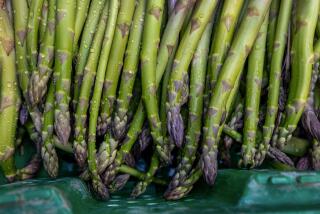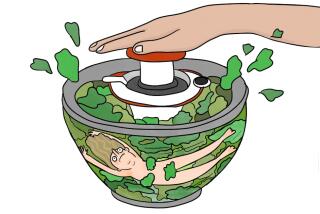Lettuce Grows Into a Processed Food
SOLEDAD, Calif. — In a field near Salinas, two teams of workers move through the muddy rows behind harvesters on a recent morning, scooping up heads of lettuce, peeling off the bushy outer leaves and chopping off their stumpy bottoms.
Both are picking iceberg lettuce for their employer, Dole Fresh Vegetables Inc. But while one team is carefully selecting the most eye-pleasing specimens, the other is grabbing just about everything in sight, even the smaller or misshapen heads that years ago would have been left in the field.
For the record:
12:00 a.m. Aug. 31, 2002 For The Record
Los Angeles Times Saturday August 31, 2002 Home Edition Main News Part A Page 2 National Desk 18 inches; 671 words Type of Material: Correction
Lettuce production--An Aug. 19 story in the Business section about California lettuce growers misspelled the name of Tom Lovelace, senior vice president of Performance Food Group Co.
It’s these leftovers that customers will eventually pay double for, once they are washed, cut and sealed into plastic bags for sale in the produce aisle as salad. Even as head lettuce prices recently hit 12-year lows--the result of a flurry of new planting after the spring lettuce shortage--bagged salad prices didn’t budge.
Salad prices have held relatively steady for years, as companies such Dole Food Co. and its chief competitor, Fresh Express, which together control about two-thirds of the $1.6-billion bagged salad market, have determined how much consumers are willing to pay for convenience.
One of California’s most volatile commodity crops is quickly turning into a consumer good whose consistency is as predictable and stable as floor wax or pretzels.
“We’re no longer in the farming business,” said Tom Loveless, a senior vice president with Fresh Express’s parent, Dallas-based Performance Food Group Co. Now, he said, “we sell a branded line of products.”
A decade after the first bagged salads began landing on supermarket shelves, these products use 40% of the lettuce grown in the Salinas Valley, the nation’s largest lettuce-growing region.
At Dole, lettuce heads roll down an assembly line just like any other packaged food before they are cut to size, mixed with pre-measured spurts of other types of greens and cabbage, washed and vacuum-packed. Some analysts contend that fresh fruits and vegetables shouldn’t be processed, sealed up and turned into slickly marketed products, but others say consumers can’t get enough. They want fresh foods but expect it to be as convenient, safe and predictable as anything they get out of a can or box.
Big agricultural businesses that used to farm Monterey County’s rich but expensive land now are processors, buying and maintaining expensive equipment and paying growers a set amount per season, per pound. In Dole’s case, a million bags of salad leave its docks here every day, winding up in markets as far away as New York within five days of harvest.
It’s a testament to how sophisticated the produce business has become and which direction some of California’s agriculture industry could be headed as shippers of every commodity look for ways to cut, mix or otherwise enhance their crops to turn a higher profit.
In the Salinas Valley, the business system has evened out the financial roller coaster for many growers.
But the stability has its price. These contract growers don’t gain from big price spikes, such as those that benefited lettuce growers in the Imperial Valley in March when cold weather drove prices to a 15-year high, said Gary Lucier, an economist with the U.S. Department of Agriculture’s Economic Research Service.
“It kind of insulates you from both the good and the bad.”
Some growers said they felt they had no choice but to turn to this type of contract production, unable to compete with the clout and marketing muscle of their larger competitors.
“As other companies started getting larger like Dole ... and gaining recognition all over the world, we found ourselves in a less-than-competitive situation,” said Ross Merrill of 70-year-old Merrill Farms in Salinas, which sells all of its lettuce production to Dole. “We looked around and said, ‘How can we survive going forward?’ One way was growing for Dole.”
The ability to turn a predictable profit has made his bankers happy, Merrill says, and it has allowed him to focus more on boosting yields, rather than worrying about the timing of his crop and the supply of lettuce headed to market.
But the concentration in the salad business also makes him a little nervous.
“I’d rather see [most of] the business in the hands of three to five people rather than two,” primarily because it would provide other markets for his production if Dole or Fresh Express decides to lower prices paid to growers.
Initially a hard sell, bagged salads have become a favorite of supermarket retailers. The product is more lucrative than head lettuce, requires less labor to maintain on the shelves and can be kept on the shelf longer, thanks to its special packaging.
Because consumers who buy bagged salad expect to pay more for the convenience, manufacturers and retail chains don’t feel the same pressure to discount the items as they do bulk produce.
At Colton-based Stater Bros. Markets there are 40 types of bagged salad on the shelf and 135 types of bagged cut-up produce products overall.
“It’s convenient,” said Jack Brown, Stater Bros. chairman and chief executive. “It’s good for smaller households.”
*
Paying for Convenience
And unlike a head of lettuce, which can sit in consumers’ crispers for six days and lose freshness, Brown says, a bagged salad can sit for a couple of weeks.
Shoppers routinely pay double for that kind of convenience. Dole officials say most shoppers don’t look to see how the price of bagged salad relates to that of bulk lettuce.
Dole’s bagged iceberg typically sells for about $1.50 to $2 for a one-pound bag. But its focus these days is mostly on the exotic leaf lettuce blends, which retail closer to $3, sometimes for as little as a 5-ounce bag.
Dole and Fresh Express officials won’t say how profitable the bagged salad business is or how much they spend on marketing. But competitors and government officials say they profit enough to aggressively market their lines, giving away cases of free products to stores and paying slotting fees to supermarkets to help their salads get the best real estate in the produce aisle.
These fees can range from $10,000 to a small retailer, according to one USDA report, to $2 million to get into one of the country’s largest chains.
The business of marketing these salads has become almost as sophisticated as that of packaged foods, and just as secretive, given the intense competition between Dole and Fresh Express--which both claim to be No. 1 (Dole by units sold, Fresh Express by dollar sales). Dole says that each year it introduces new blends, such as the baby spinach salad it will introduce this fall, while discontinuing slower-moving items so the number of items on supermarket shelves remains fairly constant.
But Dole Fresh Vegetable President Eric Schwartz acknowledges having more ambitious plans in development.
“We’re still looking at other ways to get our name on products in supermarkets.”
Loveless of Fresh Express said the company plans to begin selling cut-up packaged fruit this fall, and he hinted at main-dish salads with meat and seafood or other items that might eventually be sold.
Some growers and brokers believe that the growth of these convenience products will continue to eat up more space in the produce aisle, leaving less room for inexpensive bulk fruits and vegetables.
*
Consumption Is Up
Although to some extent they may be right, economists say, those convenience products also are growing the market.
The popularity of bagged salads has helped boost per-capita lettuce consumption in recent years to an all-time high last year of 33 pounds, just as the introduction of “baby” carrots as packaged produce lifted carrot sales dramatically in the 1990s.
Brown of Stater Bros. said he is expanding the size of the produce aisle in his new stores 25% to accommodate the growing number of items. In old stores, the chain is adjusting racks and fixtures to shoehorn in 450 fresh and packaged items.
“Produce is the No. 1 reason why people choose a supermarket,” Brown said. “If we don’t do it right, we have no reason for being,” he said, noting the intense competition from discounters such as Wal-Mart Stores Inc. and Costco Wholesale Corp.
Items such as bagged salad and baby carrots, which have become lucrative products, were initially developed as a way to use produce that would have been discarded because it was the wrong size or shape.
Trimmed down, cleaned up and bagged, these products look no different to consumers from the leaves of the fully formed heads harvested for the bulk-produce section.
And unlike bulk lettuce, which is rinsed and wrapped in the field, lettuce for bagged salad moves through an impressive germ-killing gantlet.
Moving along a conveyor belt at Dole’s plant here, for example, the loose salad first passes through a water and chlorine rinse, much like a car wash. Then it is shot across the plant in a huge liquid-filled tube before getting a third hose-down.
It’s tumbled in 250-pound metal drums to dry before being spit out in pre-measured amounts into its packaging, with most of the air sucked out and nitrogen added.
The system isn’t perfect, analysts say. It leaves some room for contamination, and not all greens can endure the rigors of the assembly line and weeks in an oxygen-free bag.
Arugula, for instance, still won’t work for bagged salad, according to Dole research.
“It just doesn’t hold up,” said Gil Oetzel, Dole’s project manager for research.
Still, about 110 products are turned out of this plant, including iceberg and endive, and special romaine and leaf lettuce blends.
Not everyone is willing to be just a spoke in the Salinas processing hub. Basil Mills, a grower-shipper in this valley for 45 years, still holds back about half of his production to sell on the bulk market.
“We’re at the mercy of the market,” Mills said. But, he said, he prefers gambling on a bigger profit. “Year to year [the lettuce market] can be bad or good. But if over time it didn’t turn a good profit, most of us wouldn’t stay in this business.”
More to Read
Inside the business of entertainment
The Wide Shot brings you news, analysis and insights on everything from streaming wars to production — and what it all means for the future.
You may occasionally receive promotional content from the Los Angeles Times.










